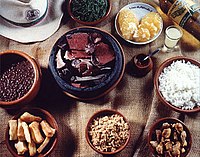 |
| Part of a series on |
| Brazilian cuisine |
|---|
| Types of food |
| See also |
Below is a list of drinks found in Brazilian cuisine.
 |
| Part of a series on |
| Brazilian cuisine |
|---|
| Types of food |
| See also |
Below is a list of drinks found in Brazilian cuisine.


A drink or beverage is a liquid intended for human consumption. In addition to their basic function of satisfying thirst, drinks play important roles in human culture. Common types of drinks include plain drinking water, milk, juice, smoothies and soft drinks. Traditionally warm beverages include coffee, tea, and hot chocolate. Caffeinated drinks that contain the stimulant caffeine have a long history.

Brazilian cuisine is the set of cooking practices and traditions of Brazil, and is characterized by European, Amerindian, African, and Asian influences. It varies greatly by region, reflecting the country's mix of native and immigrant populations, and its continental size as well. This has created a national cuisine marked by the preservation of regional differences.

Caipirinha is Brazil's national cocktail, made with cachaça, sugar, and lime. The drink is prepared by mixing the fruit and the sugar together, then adding the liquor. This can be made in a single large glass to be shared among people, or in a larger jar, from which it is served in individual glasses.
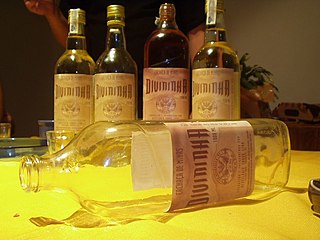
Cachaça is a distilled spirit made from fermented sugarcane juice. Also known as pinga, caninha, and other names, it is the most popular spirit among distilled alcoholic beverages in Brazil. Outside Brazil, cachaça is used almost exclusively as an ingredient in tropical drinks, with the caipirinha being the most famous cocktail. In Brazil, caipirinha is often paired with the dish feijoada.

Aguardente (Portuguese), or aguardiente (Spanish), is a type of distilled alcoholic spirit that contains between 29% and 60% alcohol by volume (ABV). It is a somewhat generic term that can refer to liquors made from various foods. It originates from and is typically consumed on the Iberian Peninsula and in Iberian America.

A sour is a traditional family of mixed drinks. Sours belong to one of the old families of original cocktails and are described by Jerry Thomas in his 1862 book How to Mix Drinks.

Advocaat or advocatenborrel is a traditional Dutch alcoholic beverage made from eggs, sugar, and brandy. The rich and creamy drink has a smooth, custard-like consistency. The typical alcohol content is generally between 14% and 20% ABV. Its contents may be a blend of egg yolks, aromatic spirits, sugar or honey, brandy, vanilla, and sometimes cream. Notable makers of advocaat include Warninks, Bols, Darna Ovo Liker, DeKuyper, and Verpoorten.
Quimbanda, also spelled Kimbanda, is an Afro-Brazilian religion practiced primarily in the urban city centers of Brazil. Quimbanda practices are typically associated with magic, rituals with Exus, and Pombagiras spirits. Quimbanda was originally contained under the religious tradition of Macumba. In the early years of the 21st century some began to assert that Quimbanda was totally separate from Umbanda. Umbanda represented the more Europeanized traits of the religion. Quimbanda has continued to insist that it is a distinct religion, while rejecting Catholic and Kardecist Spiritist influences that have penetrated Umbanda and other Afro-Brazilian religions.
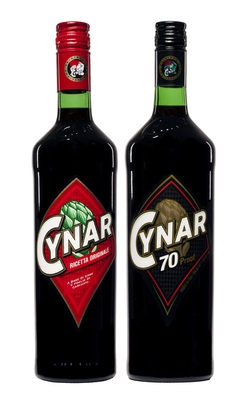
Cynar is an Italian bitter apéritif of the amaro variety. It is made from 13 herbs and plants, predominant among which is the artichoke, from which the drink derives its name. Cynar is dark brown, has a bittersweet flavor, and its strength is 16.5% ABV. It was launched in Italy in 1952.

Batida is a Brazilian cocktail, and is one of several Brazilian cocktails that are made with the national alcoholic drink cachaça. In Portuguese batida means shaken or milkshake, and the word also means a crash, usually used when referring to a car crash. This beverage is made with cachaça, fruit juice, and sugar. It is blended or shaken with ice.
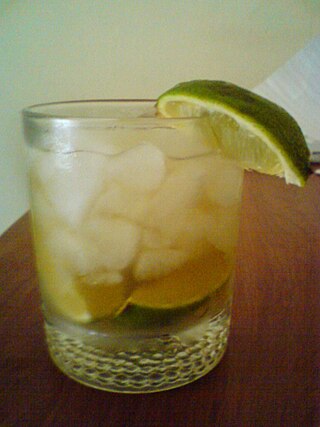
Caipiroska or caipivodka is a cocktail that is similar to a caipirinha, but prepared with vodka instead of cachaça. It is a popular cocktail in Brazil, Paraguay, Uruguay and Argentina. It is also sometimes known as caipirodka. It has grown in popularity in recent years as access to international vodkas continues to diversify in South America.

There are many cocktails made with cachaça, the national spirit of Brazil. The caipirinha is by far the most popular and internationally well-known, but bartenders have developed other mixed drinks using the spirit.

Sugarcane juice is the liquid extracted from pressed sugarcane. It is consumed as a beverage in many places, especially where sugarcane is commercially grown, such as Southeast Asia, the Indian subcontinent, North Africa, and Latin America. Sugarcane juice is obtained by crushing peeled sugar cane in a mill and is one of the main precursors of rum.

A lemon drop is a vodka-based cocktail that has a lemony, sweet and sour flavor, prepared using lemon juice, triple sec and simple syrup. It has been described as a variant of, or as "a take on", the vodka martini, but is in actual fact a closer to a white lady variant. It is typically prepared and served straight up – chilled with ice and strained.
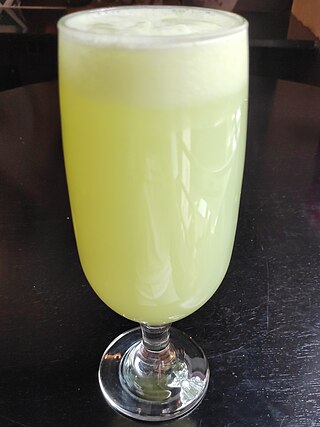
Swiss lemonade or limonada suíça is a type of Brazilian lemonade made of lime pieces with peel, ice cubes, sugar, and water. The ingredients are usually beaten together in a blender and then strained. There are several versions of this drink, including one with condensed milk.

Mint lemonade is lemonade flavored with mint. It may be made with whole mint leaves, mint-flavored syrup, or pureed mint leaves, and may be served over ice cubes or blended with ice into a slush or smoothie. It is sometimes called a virgin mojito.